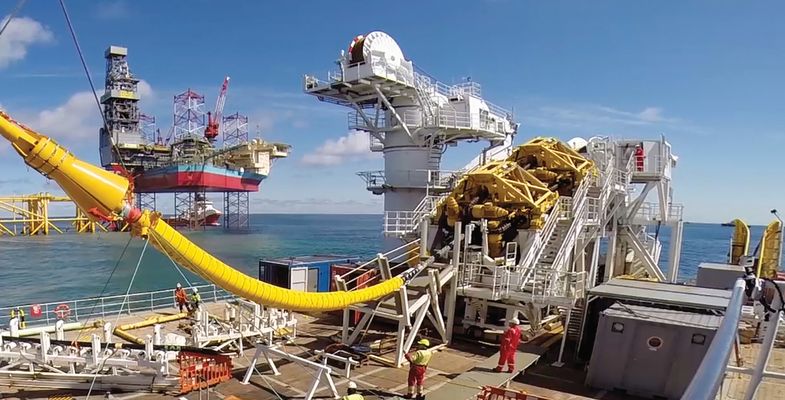DNV-ST-0359 Subsea Power Cable Design and Testing
The DNV-ST-0359 Subsea Power Cable Design and Testing is a comprehensive set of guidelines developed by DNV GL to ensure the safety, reliability, and performance of subsea power cables used in marine renewable energy projects. These cables are critical components that deliver electricity from offshore wind farms or wave energy converters to shore-based substations.
The standard aims at providing a robust framework for design, manufacture, installation, commissioning, operation, and maintenance of these cables. By adhering to DNV-ST-0359, stakeholders can mitigate risks associated with subsea power cable failures which can lead to significant financial losses as well as environmental impacts.
The guidelines are particularly important in the context of renewable energy where reliability is paramount due to the high costs involved and the long-term nature of these projects. The standard covers various aspects including:
- Design considerations
- Mechanical properties
- Electrical characteristics
- Environmental impact assessment
- Installation procedures
- Testing protocols
- Operational guidelines
The document specifies test methods and acceptance criteria for subsea power cables, ensuring they meet the required standards before deployment. Compliance with this standard ensures that all involved parties—from manufacturers to operators—are working towards a common goal of safety and reliability.
In summary, DNV-ST-0359 is an essential tool in the design and testing process of subsea power cables used in renewable energy projects. It helps stakeholders ensure their products meet stringent requirements set by international standards like IEC 60287 and EN 50412.
Why It Matters
The importance of the DNV-ST-0359 Subsea Power Cable Design and Testing cannot be overstated, especially in light of increasing investments in offshore renewable energy infrastructure. Reliable subsea power cables are crucial for ensuring uninterrupted supply of electricity from marine-based renewable sources to shore.
Failure of these cables can result in extended downtime, increased operational costs, potential damage to equipment, and even environmental harm if the cable breaks underwater. By adhering to this standard, stakeholders ensure that their products not only meet but exceed industry expectations regarding safety and performance.
The guidelines also promote best practices throughout the lifecycle of a subsea power cable—from initial design through installation, operation, and eventual decommissioning. This holistic approach ensures long-term sustainability and reduces operational risks for both developers and operators.
Furthermore, compliance with DNV-ST-0359 demonstrates commitment to high-quality standards which can enhance market credibility and competitive advantage. It reassures investors about the reliability of projects while fostering trust among regulatory bodies responsible for overseeing renewable energy initiatives.
Applied Standards
The DNV-ST-0359 Subsea Power Cable Design and Testing is primarily aligned with international standards such as IEC 60287, which provides general requirements for power cables. Additionally, it draws upon EN 50412:2015 for specific technical details related to subsea power cable design.
The standard incorporates best practices from various sectors including marine engineering, electrical engineering, and environmental science. By referencing these established norms, DNV-ST-0359 ensures that it remains current with evolving technologies and regulatory requirements.
Key areas covered by the standard include:
- Mechanical strength testing
- Electrical performance evaluation
- Environmental impact assessment
- Cable installation procedures
- Testing protocols during maintenance intervals
- Operational guidelines for safe deployment
The combination of these elements ensures that subsea power cables are designed and tested to meet the highest levels of safety, reliability, and efficiency.
Industry Applications
- Offshore Wind Farms: Ensuring continuous power supply from wind turbines to shore-based substations.
- Wave Energy Converters: Delivering electricity generated by waves directly to the grid.
- Ocean Thermal Energy Conversion (OTEC): Facilitating transmission of OTEC-generated electricity to land.
- Battery Storage Systems: Connecting large-scale battery storage facilities with renewable energy sources via subsea cables.
- Marine Aquaculture: Providing power for remote fish farms situated far from the shore.
- Offshore Oil & Gas: Supporting oil and gas platforms by delivering necessary power through subsea infrastructure.
The versatility of these cables makes them indispensable in various marine applications where reliable electrical transmission is critical. Compliance with DNV-ST-0359 guarantees that the subsea power cables used in these sectors are robust enough to withstand harsh ocean conditions and perform optimally under operational demands.





